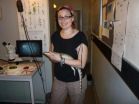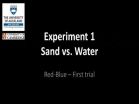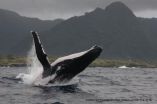(Press-News.org) Armed with a ferocious pair of mandibles, male stag beetles appear well prepared to take on the world. 'Their jaws are not just for ornamentation, they really use them to fight', says Jana Goyens from the University of Antwerp, Belgium, adding that males grapple over the choicest patches of rotten wood for their mates to lay their eggs in. Describing a stag beetle battle, Goyens explains that one beetle grabs the other one around its body and then rears up in an attempt to hurl his opponent over his head and onto its back. 'It is clear which one is the loser', says Goyens. But something puzzled her: 'It seemed unlikely that stag beetles could bite forcefully because they have these long jaws', she says. Instead of amplifying forces, the beetles' long mandibles would reduce the forces exerted at the sharp teeth halfway along the mandibles when gripped together. Intrigued, Goyens and her supervisors, Joris Dirckx and Peter Aerts, decided to test how powerful stag beetle bites are. They report their discovery that male stag beetles have enlarged their heads and muscles to insure that their bite force is not weakened in The Journal of Experimental Biology at http://jeb.biologists.com.
Although the beetles are native to Belgium, they are endangered, so Goyens turned to Asia, where betting on insect fights is popular, to obtain the animals. However, when 10 pairs of the animals arrived from Taiwan just before Christmas, the pressure was on. 'I had been told that they only live for a couple of months but I didn't know how old they were and it was the Friday before the Christmas holidays so I worked the entire holiday to get as much data as possible while they were still alive', says Goyens, who laughs when she recalls that the beetles went on to live for another 12 months.
Testing the beetles' bite force, Goyens found that the aggressive animals were extremely cooperative, biting enthusiastically on the force transducer whenever it was held before them. And when she compared the strength of the male's and female's bites, she was impressed to see that the male's jaws gripped with an impressive 7N force (which is like having a 700g weight pressing on a pin): six times stronger than the female's bite. Even when she scaled up the female's bite to take account of the female's smaller stature, the male's bites were still three times stronger. So, even though the male's long mandibles should reduce the strength of their nasty nips, they were still able to clamp on much harder than the females. They must have somehow compensated for their oversized mandibles; Goyens decided to take a closer look at the beetles' heads.
Comparing the males and females, Goyens realised that the males' heads were much wider than the females', suggesting the males had increased the size of some of the internal structures that move the mandibles to compensate for their size. Goyens then teamed up with Luc Van Hoorebeke and Manuel Dierick to take CT scans of the insects' heads to find out what was going on inside. She could clearly see that the muscle that pulls on the mandible is almost four times larger in male stag beetles than in females, and the lever on the side of the mandible that is pulled by the muscle is more than three times longer than the lever on female mandibles. And when Goyens checked the direction that the muscle pulls in, she saw that both the male's and females' muscles were perfectly oriented to generate the hardest bite. So, the males have successfully compensated for their ungainly mandibles by increasing the size of the internal structures that wield their mighty weapons.
INFORMATION:
IF REPORTING THIS STORY, PLEASE MENTION THE JOURNAL OF EXPERIMENTAL BIOLOGY AS THE SOURCE AND, IF REPORTING ONLINE, PLEASE CARRY A LINK TO: http://jeb.biologists.org/content/217/7/1065.abstract
REFERENCE: Goyens, J., Dirckx, J., Dierick, M., Van Hoorebeke, L. and Aerts, P. (2014). Biomechanical determinants of bite force dimorphism in Cyclommatus metallifer stag beetles. J. Exp. Biol. 217, 1065-1071.
This article is posted on this site to give advance access to other authorised media who may wish to report on this story. Full attribution is required, and if reporting online a link to jeb.biologists.com is also required. The story posted here is COPYRIGHTED. Therefore advance permission is required before any and every reproduction of each article in full. PLEASE CONTACT permissions@biologists.com
THIS ARTICLE IS EMBARGOED UNTIL WEDNESDAY, 26 March 2014, 18:00 HRS EDT (22:00 HRS GMT)
Stag beetle males give nasty nips despite massive jaws
2014-03-27
ELSE PRESS RELEASES FROM THIS DATE:
Reproducible research, dynamic documents, and push-button publishing
2014-03-27
March 26, 2014, Hong Kong, China –The international open-access journal GigaScience (a BGI and BioMed Central journal) today announces a major step forward for reproducible research and public data-sharing in the neurosciences with the publication and release of a huge cache of electrophysiology data resources. Important for studying visual development, many groups have been using multielectrode array recordings to look at developmental changes and the effects of various genetic defects on the spontaneous activity of the retina. In neuroscience, public sharing of data is ...
Economic growth has little impact on reducing undernutrition in children
2014-03-27
A large study of child growth patterns in 36 developing countries published in The Lancet Global Health journal has found that, contrary to widely held beliefs, economic growth is at best associated with very small, and in some cases no declines in levels of stunting, underweight, and wasting. This suggests that investment in interventions that directly impact health and nutrition are needed to tackle child undernutrition.
Worldwide, malnutrition contributes to 2.6 million child deaths each year, or more than one in three of all child deaths. In 2011, an estimated 165 ...
Economic growth no cure for child undernutrition
2014-03-27
Boston, MA —A large study of child growth patterns in 36 developing countries finds that, contrary to widely held beliefs, economic growth has little to no effect on the nutritional status of the world's poorest children. The study, from researchers at Harvard School of Public Health (HSPH), the University of Göttingen, Germany, ETH Zürich, Switzerland, and the Indian Institute of Technology Gandhinagar, found that economic growth was associated with small or no declines in stunting, underweight, and wasting—all signs of undernutrition.
"These findings represent a potentially ...
Canal between ears helps alligators pinpoint sound
2014-03-27
By reptile standards, alligators are positively chatty. They are the most vocal of the non-avian reptiles and are known to be able to pinpoint the source of sounds with accuracy. But it wasn't clear exactly how they did it because they lack external auditory structures.
In a new study, an international team of biologists shows that the alligator's ear is strongly directional because of large, air-filled channels connecting the two middle ears. This configuration is similar in birds, which have an interaural canal that increases directionality.
"Mammals usually have ...
Cuvier's beaked whales set new breath-hold diving records
2014-03-26
Scientists monitored Cuvier's beaked whales' record-breaking dives to depths of nearly two miles below the ocean surface and some dives lasted for over two hours, according to results published March 26, 2014, in the open access journal PLOS ONE by Gregory Schorr from Cascadia Research Collective and colleagues.
Distributed throughout the world's oceans, the Cuvier's beaked whales' frequent dives deep into the ocean make them difficult for researchers to study. Previous studies using short-term tags (~ 215 hours of data) have indicated that this deep-diving species might ...
Crows complete basic 'Aesop's fable' task
2014-03-26
VIDEO:
This video shows example trials for each of the six experiments.
Click here for more information.
New Caledonian crows may understand how to displace water to receive a reward, with the causal understanding level of a 5-7 year-old child, according to results published March 26, 2014, in the open access journal PLOS ONE by Sarah Jelbert from University of Auckland and colleagues.
Understanding causal relationships between actions is a key feature of human cognition. However, ...
Humpback whale populations share core skin bacterial community
2014-03-26
Humpback whales share a simplistic skin bacterial community across populations, according to results published March 26, 2014, in the open access journal PLOS ONE by Amy Apprill from the Woods Hole Oceanographic Institution and colleagues. The overall bacterial communities differ by geographic area and by metabolic state, such as feeding versus starving during migration and breeding.
Bacterial communities living on mammal skin may play a role in their health; for humans, there is a relationship between skin bacteria and allergic or inflammatory conditions. While skin ...
New drug successfully treats crizotinib-resistant, ALK-positive lung cancer
2014-03-26
Although the targeted cancer treatment drug crizotinib is very effective in causing rapid regression of a particular form of lung cancer, patients' tumors inevitably become resistant to the drug. Now a new drug called ceritinib appears to be effective against advanced ALK-positive non-small cell lung cancer (NSCLC), both in tumors that have become resistant to crizotinib and in those never treated with the older drug. The results of a phase 1 clinical trial conducted at centers in 11 countries are reported in the March 27 New England Journal of Medicine.
"Crizotinib ...
Patches of cortical layers disrupted during early brain development in autism
2014-03-26
Researchers at the University of California, San Diego School of Medicine and the Allen Institute for Brain Science have published a study that gives clear and direct new evidence that autism begins during pregnancy.
The study will be published in the March 27 online edition of the New England Journal of Medicine.
The researchers – Eric Courchesne, PhD, professor of neurosciences and director of the Autism Center of Excellence at UC San Diego, Ed S. Lein, PhD, of the Allen Institute for Brain Science in Seattle, and first author Rich Stoner, PhD, of the UC San Diego ...
Bamboo-loving giant pandas also have a sweet tooth
2014-03-26
PHILADELPHIA (March 26, 2014) – Despite the popular conception of giant pandas as continually chomping on bamboo to fulfill a voracious appetite for this reedy grass, new research from the Monell Center reveals that this highly endangered species also has a sweet tooth. A combination of behavioral and molecular genetic studies demonstrated that the giant panda both possesses functional sweet taste receptors and also shows a strong preference for some natural sweeteners, including fructose and sucrose.
"Examining an animal's taste DNA can give us clues to their past diet, ...



